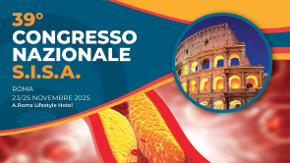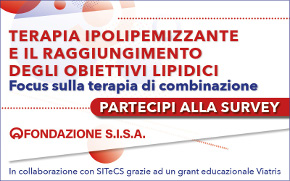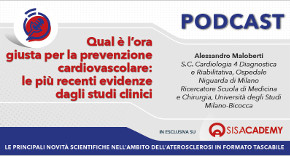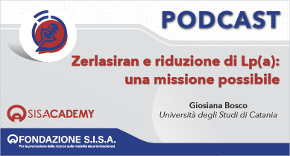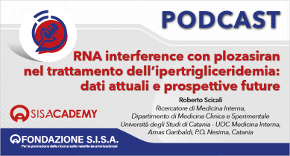 Rivista in lingua italiana
Rivista in lingua italiana
riservata ai Soci SISA
Ultimo numero:
Anno 16 • N.1/2025
Abstract
ESC/EAS Guidelines for the management of dyslipidaemias The Task Force for the management of dyslipidaemias of the European Society of Cardiology (ESC) and the European Atherosclerosis Society (EAS)
Catapano AL, Reiner Z, De Backer G, Graham I, Taskinen MR, Wiklund O, Agewall S, Alegria E, Chapman MJ, Durrington P, Erdine S, Halcox J, Hobbs R, Kjekshus J, Filardi PP, Riccardi G, Storey RF, Wood D
Atherosclerosis 2011;217:3-46
Cardiovascular disease (CVD) due to atherosclerosis of the arterial vessel wall and to thrombosis is the foremost cause of premature mortality and of disability-adjusted life years (DALYs) in Europe, and is also increasingly common in developing countries. In the European Union, the economic cost of CVD represents annually ~€192 billion in direct and indirect healthcare costs.
The main clinical entities are coronary artery disease (CAD), ischaemic stroke, and peripheral arterial disease (PAD).
The causes of these CVDs are multifactorial. Some of these factors relate to lifestyles, such as tobacco smoking, lack of physical activity, and dietary habits, and are thus modifiable. Other risk factors are also modifiable, such as elevated blood pressure, type 2 diabetes, and dyslipidaemias, or non-modifiable, such as age and male gender.
These guidelines deal with the management of dyslipidaemias as an essential and integral part of CVD prevention.
Prevention and treatment of dyslipidaemias should always be considered within the broader framework of CVD prevention, which is addressed in guidelines of the Joint European Societies' Task forces on CVD prevention in clinical practice. The latest version of these guidelines was published in 2007; an update will become available in 2012.
These Joint ESC/European Atherosclerosis Society (EAS) guidelines on the management of dyslipidaemias are complementary to the guidelines on CVD prevention in clinical practice and address not only physicians [e.g. general practitioners (GPs) and cardiologists] interested in CVD prevention, but also specialists from lipid clinics or metabolic units who are dealing with dyslipidaemias that are more difficult to classify and treat.
Pagina riservata ai soci SISA dedicata alle linee guida EAS/ESC

Area Soci
Eventi
39° Congresso Nazionale
 39° Congresso Nazionale
39° Congresso NazionaleRoma, 23-25 novembre 2025
Save the date




 Spring Meeting Gruppi Giovani SID, SIGG, SIIA, SIMI, SIPREC, SISA
Spring Meeting Gruppi Giovani SID, SIGG, SIIA, SIMI, SIPREC, SISARimini, 6-8 aprile 2025
[continua a leggere]
 SISA LIPID ACADEMY - Corso avanzato di lipidologia clinica
SISA LIPID ACADEMY - Corso avanzato di lipidologia clinicaModena, 4-5 Luglio 2024
[continua a leggere]Giornale Italiano Arteriosclerosi
HoFH today
 Rivista Italiana della
Rivista Italiana della
Ipercolesterolemia
Familiare Omozigote
Anno 6 • N.1/2024
Rivista NMCD
Diateca
[continua a leggere]
[continua a leggere]
Newsletter
il vostro indirizzo di posta elettronica
Progetto LIPIGEN

Nuovo sito dedicato al Progetto LIPIGEN
Progetto LIPIGEN - Vecchio portale
E' necessario essere loggati come utente
Lipigen per poter accedere alla pagina
PROject Statin Intolerance SISA
PROSISA – PROject Statin Intolerance SISA
E' necessario essere loggati come utente
PROSISA per poter accedere alla pagina
GILA - Lipoprotein Aferesi
Gruppo Interdisciplinare Lipoprotein Aferesi
(Accesso Gruppo GILA-Lipoprotein Aferesi)
E' necessario essere loggati come utente del Gruppo GILA per poter accedere
Gruppo Interdisciplinare Lipoprotein Aferesi
(Documentazione ad accesso libero)
Pagina informativa per medici e pazienti


